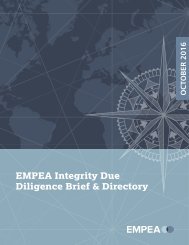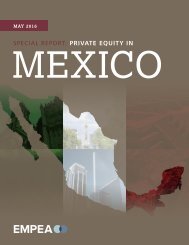You also want an ePaper? Increase the reach of your titles
YUMPU automatically turns print PDFs into web optimized ePapers that Google loves.
and in fact in some instances have brought about innovation<br />
in regulatory practices more generally. 1<br />
To the extent that establishing or developing a FC is part <strong>of</strong> a<br />
conscious development strategy, the objectives are usually<br />
related to economic diversification, with the objectives <strong>of</strong><br />
generating economic activity (output), employment, fiscal<br />
revenues or export earnings.<br />
They may also have secondary<br />
objectives <strong>of</strong> providing additional<br />
opportunities for domestic<br />
investors (e.g., institutions)<br />
or attracting inflows <strong>of</strong> capital<br />
into the domestic economy.<br />
The relative magnitudes <strong>of</strong><br />
domestic and international<br />
inflows and outflows in Figure<br />
2 will vary considerably across<br />
FCs. The flows in a classic<br />
<strong>of</strong>fshore financial centre would<br />
be mainly A-C.<br />
Overall, there are many<br />
dimensions to a Financial<br />
Centre: the size <strong>of</strong> its<br />
international business relative<br />
to domestic business, with<br />
regard to both sources <strong>of</strong><br />
investment funds and the destination <strong>of</strong> investments;<br />
the source and destination <strong>of</strong> the international business<br />
(regional, global); the nature <strong>of</strong> the business undertaken,<br />
whether balance sheet-based or fee-based; whether<br />
primarily administrative or including substantive<br />
management activities; and the extent <strong>of</strong> compliance with<br />
international requirements and best practice regarding legal<br />
structures, transparency and disclosure. This complexity<br />
does not really facilitate a simple distinction between<br />
<strong>of</strong>fshore and onshore financial centres.<br />
2. CLASSIFICATION OF<br />
FINANCIAL CENTRES<br />
Depending on the basis <strong>of</strong> classification, around 100<br />
jurisdictions may be identified as financial centres globally.<br />
The most direct classifications are the IMF’s listing <strong>of</strong><br />
Offshore Financial Centres (OFCs), and the Global<br />
Financial Centre Index (GFCI). 2<br />
Indirect listings include the<br />
OECD listing <strong>of</strong> jurisdictions<br />
that have been reviewed for the<br />
Global Forum on Transparency<br />
and Exchange <strong>of</strong> Information<br />
for Tax Purposes, 3 and the<br />
Tax Justice Network’s listing <strong>of</strong><br />
jurisdictions from a “financial<br />
secrecy” perspective (focussed<br />
on what are more commonly<br />
known as “tax havens”). 4<br />
The IMF’s listing <strong>of</strong> Offshore<br />
Financial Centres relates to<br />
its programme <strong>of</strong> specific<br />
assessment <strong>of</strong> OFCs as a<br />
result <strong>of</strong> concerns about<br />
weaknesses in financial<br />
supervision in OFCs and a lack<br />
<strong>of</strong> information regarding their<br />
activities. This programme ran from 2000 to 2008, when<br />
OFC surveillance was integrated with the broader Financial<br />
Sector Assessment Programme (FSAP). Between 2000<br />
and 2008, 53 OFC jurisdictions were identified for inclusion<br />
in the programme. However, the IMF has not used the OFC<br />
classification since 2008.<br />
The GFCI (2014) rates 83 cities across a range <strong>of</strong> criteria<br />
and provides an overall ranking <strong>of</strong> GFCs. The GFCI ranks<br />
cities rather than countries. After including financial centres<br />
that are awaiting inclusion in the GFCI, there is a total <strong>of</strong> 96<br />
cities in 69 countries. Of this total, 11 locations are identified<br />
specifically as <strong>of</strong>fshore financial centres.<br />
1<br />
Morriss, A and Henson, C. (2012) Regulatory Effectiveness in Onshore and Offshore Financial Centers, University <strong>of</strong> Alabama School <strong>of</strong> Law<br />
Working Paper.<br />
2<br />
IMF (2008) Offshore Financial Centers: A Report on the Assessment Program and Proposal for Integration with the Financial Sector Assessment<br />
Program; Z/Yen Group (2014) Global Financial Centres Index 16.<br />
3<br />
OECD / Global Forum on Transparency and Exchange <strong>of</strong> Information for Tax Purposes (2014) Tax Transparency – Report on Progress 2014 (OECD).<br />
4<br />
See: http://www.financialsecrecyindex.com/.<br />
70 |





